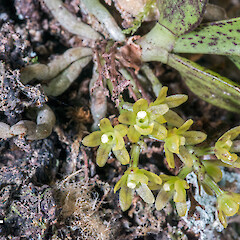Drymoanthus flavus
Common name
spotted fleshy tree orchid
Synonyms
None
Family
Orchidaceae
Flora category
Vascular – Native
Endemic taxon
Yes
Endemic genus
No
Endemic family
No
Structural class
Orchids
NVS code
The National Vegetation Survey (NVS) Databank is a physical archive and electronic databank containing records of over 94,000 vegetation survey plots - including data from over 19,000 permanent plots. NVS maintains a standard set of species code abbreviations that correspond to standard scientific plant names from the Ngä Tipu o Aotearoa - New Zealand Plants database.
DRYFLA
Chromosome number
2n = 38
Current conservation status
The conservation status of all known New Zealand vascular plant taxa at the rank of species and below were reassessed in 2017 using the New Zealand Threat Classification System (NZTCS) – more information about this can be found on the NZTCS website. This report includes a statistical summary and brief notes on changes since 2012 and replaces all previous NZTCS lists for vascular plants.
Please note, threat classifications are often suggested by authors when publications fall between NZTCS assessment periods – an interim threat classification status has not been assessed by the NZTCS panel.
- Conservation status of New Zealand indigenous vascular plants, 2017 . 2018. Peter J. de Lange, Jeremy R. Rolfe, John W. Barkla, Shannel P. Courtney, Paul D. Champion, Leon R. Perrie, Sarah M. Beadel, Kerry A. Ford, Ilse Breitwieser, Ines Schönberger, Rowan Hindmarsh-Walls, Peter B. Heenan and Kate Ladley. Department of Conservation. Source: NZTCS and licensed by DOC for reuse under the Creative Commons Attribution 4.0 International licence.
2017 | At Risk – Declining | Qualifiers: DP, Sp
Previous conservation statuses
2012 | At Risk – Naturally Uncommon | Qualifiers: PD, Sp
2009 | At Risk – Naturally Uncommon
2004 | Serious Decline
Distribution
Endemic. New Zealand: North Island, scattered sites from Waitomo, Whirinaki Forest and Te Kopia Geothermal Reserve (Paeroa Range) to Wellington and Palliser Bay), South Island (sparsely distributed, only becoming more common in southern Otago, Southland), Stewart Island/Rakiura.
Habitat
A trunk and branch epiphyte of lowland to montane forest.
Detailed description
Diminutive epiphyte of trunks and branches relatively clean of other epiphytic plants. Occasionally found on rock outcrops and cliff faces. Forming branched, leafy, tufts (20)–30–60–(80) mm diameter, with many white to brown, cord-like roots firmly attached to substrate. Leaves (10)–30–50–(70) × (5)–15–(20) mm, green or yellowish green, frequently purple spotted, leathery, elliptic to lanceolate, with acute often twisted tips. Inflorescences racemose, one or more per stem, up to 50 mm long, bearing (1)–2–6–(10) flowers. Flowers at first yellowish-green flecked with purple, maturing yellow. Lateral sepals and petals subequal, spreading widely but projecting forwards and inwards to form a cup; lateral sepals shorter, petals 2.5–3 × 1.5 mm. . Dorsal sepal 3.5–4 × 1.5 mm. Labellum 2 × 1.8 mm, projected forwards, immobile, concave, channelled, apex thickened, fleshy, clear yellow, lacking distal lamina calli. Capsule 15 × 5 mm, fusiform, yellowish green and purple spotted.
Manaaki Whenua Online Interactive Key
Similar taxa
Allied to Drymoanthus adversus from which it differs by its smaller size; thinner more leathery, elliptic to lanceolate, acute, dull pale green, mostly spotted leaves; yellow flowers; trough-shaped labellum without distal lamina calli; frequently spotted capsules; and by its diploid chromosome number.
Flowering
October–November
Flower colours
Green, Yellow
Fruiting
December–July
Life cycle
Minute seeds are wind dispersed (Thorsen et al., 2009).
Propagation technique
Difficult. Should not be removed from the wild. Plants can be grown by strapping them to a log, or wood slab and placing them suspended in a sheltered, warm position. Water frequently until well established.
Threats
Threatened by indiscriminate plant collectors. With some well known locations stripped bare in recent years.
Etymology
flavus: Pale yellow
Where To Buy
Not commercially available but plants are held by specialist growers.
Attribution
Fact sheet prepared for NZPCN by P.J. de Lange 1 August 2003. Description based on Molloy & St George (1994).
References and further reading
Molloy BPJ, St. George IM. 1994. A new species of Drymoanthus (Orchidaceae) from New Zealand, and typification of D. adversus. New Zealand Journal of Botany 32(4): 415–421. https://doi.org/10.1080/0028825X.1994.10412928.
Thorsen MJ, Dickinson KJM, Seddon PJ. 2009. Seed dispersal systems in the New Zealand flora. Perspectives in Plant Ecology, Evolution and Systematics 11: 285–309. https://doi.org/10.1016/j.ppees.2009.06.001.
NZPCN Fact Sheet citation
Please cite as: de Lange, P.J. (Year at time of access): Drymoanthus flavus Fact Sheet (content continuously updated). New Zealand Plant Conservation Network. https://www.nzpcn.org.nz/flora/species/drymoanthus-flavus/ (Date website was queried)













